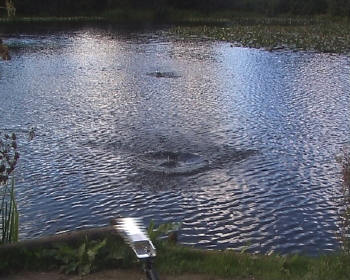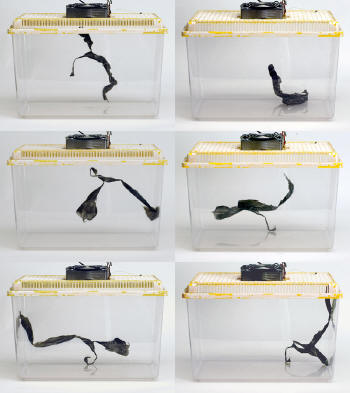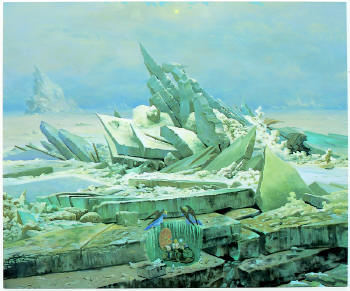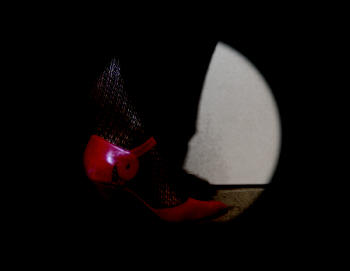 |
||
| home | features | exhibitions | interviews | profiles | gazetteer | links | archive | forum | ||
|
|
||
|
Art Now Cornwall Tate St Ives
For most of the last decade and more the first gallery (Gallery 1) at Tate St Ives has been home to the oldest and probably most important items in the Tate collection. Deciding to have these hugely revered but familiar works removed to one of the back rooms to make way for Art Now Cornwall, was, in curatorial terms, audacious and bold.
Between them were several paintings by Michael Porter, including the visionary 'Issel Road', that were poised tantalisingly between representation and abstraction; together with joyful abstract paintings by Matthew Lanyon and Iain Robertson. Andy Hughes showed two of his compelling 'Dominant Wave Theory' series of photographs on the same wall, as well as another close to the entrance.
Occupying the centre of the room and placed casually on a trestle
table were Andy Currie's collection of lo-fi
kinetic sculptures: familiar objects blown into a
mesmeric dances by small electric fans. On the opposite wall were abstract
still-lives by Jessica Cooper, and an informal neo-geo painting by Clare Wardman.
Richard Nott's industrial-looking painterly construction, 'Striation',
made Looming over the stairs down to the lower gallery was a whimsical painting by Jesse Leroy Smith of a child wearing a leopard print head-dress, and round the corner Sax Impeys' massive work 'Event 9' evocative of the sea and weather charts that featured on the cover of the catalogue. In the studio space were a selection of quieter, more introverted works: Harriet Bell's seed-like forms in wax, Partou Zia's self-portraits in pencil on paper, a beguiling monochrome painting by Naomi Frears and other works by Cathy Watkins, Lisa Wright and Jesse Leroy Smith. In the curving lower gallery facing the sea was a strongly tactile seascape by Richard Cook, and as if paired with it, an epic parody of history painting called 'Asleep by the light of glow-worms' by Ged Quinn. This work depicted Joseph Beuys explaining pictures to a dead hare while sitting in a time-machine, and although it incorporated art-historical references and symbolism, any coherent reading was overwhelmed by the simple grandeur of the image. Beyond that was another apparent pairing this time of figurative paintings by Lisa Wright and Partou Zia, and between them a large, gestural abstract painting by Mark Surridge.
There were also some works shown somewhat apart from the main galleries. On the balcony overlooking the lower gallery was a video by Hadrian Piggott of rubbish floating on churning water. Strangely hypnotic, many viewers would have wrongly assumed it was a depiction of a cornish wave, but in fact it was filmed in Italy (hence the footballs?). In the entrance hall was a performance/ installation by Amanda Lorens. For the first weekend of the show, tango dancers danced hidden behind a crisp white wall. The audience could only see them through peep-holes in the wall, which served to separate the dancing, as an intimate private act, from the public gallery space. Above that, was another charming work by Andy Currie consisting of a bin-liner agitated by desk-top fans. Away from the main Tate gallery, Delpha Hudson showed visitors around the Barbara Hepworth Museum as part of an artists performance. To what extent did the show achieve what it set out to? As is always the case with survey exhibitions, there were artists in Cornwall who felt aggrieved that they were not included. Whilst in London, for example, artists tend to understand the rules of engagement, and the processes by which shows are selected and curated, the situation in Cornwall is less straight forward because the same rules cannot be applied. Partly because of the artistic legacy, the audience is different, the infra-structure is different and the debates are different. In particular there seems a wider gap between private galleries and artists making new art: this is because many of those galleries have a commercial interest in promoting art that tends to look backwards rather than forwards. The Tate has, however, become the most important arbiter of taste in the visual arts, and the consequences of stamping its approval and authority on some art-works and not on others would, to many, seem huge. Under the circumstances it is inevitable that the process of selecting the work and curating the show was scrutinised very closely by the local artist community: it prompted considerable debate, and even spawned an alternative show at Goldfish in Penzance. Although
it was therefore a difficult show
to put on, it did an
excellent job of reconciling
and bringing together a number of competing
interests and tendencies. It managed to point to
the future whilst acknowledging tradition, it
mixed older artists with younger ones, artists
represented by private galleries and artists not, and broadly
speaking it had representative works in
each of the main genres (photography, performance, video, installation,
sculpture and painting). As
well as managing to present a comprehensive overview of this creative
diversity, the exhibition was
also installed in a way that
made the work accessible,
One of the most significant features of the show was that straight-forward depictions of the landscape, which has been staple subject matter for generations of Cornish artists, were conspicuous by their absence. Although in the catalogue, the curators express surprise that 'the landscape is not a predominant subject for many artists in Cornwall', it has to be viewed as having been a curatorial decision not to include more landscape-work, as in fact there are any number of accomplished artists who still work in this way. If so, one might conclude that depicting the landscape, even in a way that is formally inventive or original, is not considered enough in itself any more: most of the works included in the show that referenced the landscape did so obliquely and in ways that revealed the historical, social and political meanings that attach to it. What else did the show tell us about art in Cornwall? To an outsider, aspects of the selection suggested that a lot of art made locally lacks originality or 'edge': it is too restrained and polite, and avoids polemic or difficult subject matter. This is especially true of certain sectors of art activity in Cornwall, and there are good reasons for it. As most private gallery-owners will admit, much art from Cornwall is conditioned to be conservative because of the nature of the local art-market. This market is shaped hugely by the all-pervading influence of the 'artistic legacy' - itself packaged for easy consumption by the Tate. It is not surprising therefore that art buyers have expections that art from Cornwall should have a certain non-threatening and familiar retro quality. The issue for the public galleries, and shows like Art Now Cornwall, is the extent to which they should challenge this state of affairs. Many feel that the current show achieved this in part, but could have gone further.
In fact, in its defence, the private galleries have had a lot of
influence in recent years because of
a lack of credible alternatives.
Cornish art is at a cross-roads. No longer able to rely on past glories, it has made the move away from the relative certainties of modernism into the uncertain world of ‘post-modern’ art tentatively and reluctantly, and has yet to fully assert its own identity and direction. Making good and interesting art is difficult and needs support from the right kind of infra-structure. Because of this, there are probably only a handful of artists living and working down here who are currently good enough to 'compete' on a national or international stage. That’s the bad news. The good news is that, on the evidence of this show and others, there are a lot more who have the potential to do so.
images from top to bottom: Jonty Lees, Andy Whall, Andy Currie, Ged Quinn, Amanda Lorens. Why not respond to this review on the forum or submit your own review for publishing on the site...
|
||




